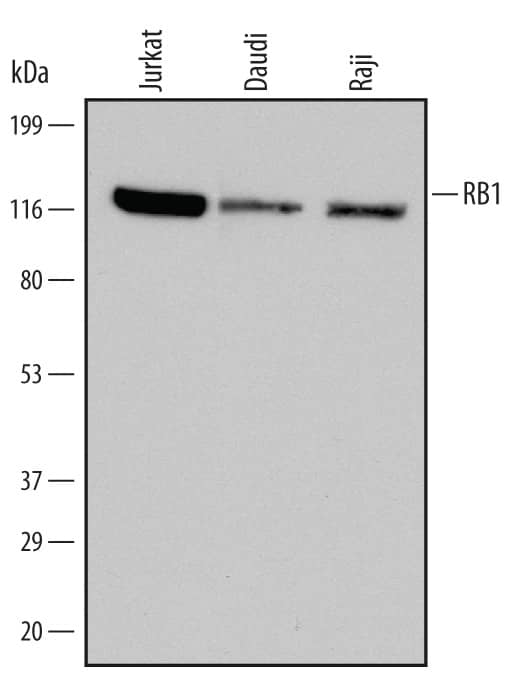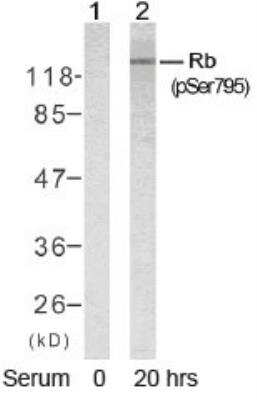RB1 Products
Retinoblastoma 1 (RB1), also known as pRb, is a 928 amino acid (aa) protein with a predicted molecular weight of 106 kDa. It is primarily a nuclear protein, but can also be exported to the cytoplasm. Human RB1 shares 91% and 90% aa sequence identity with the mouse and rat orthologs, respectively. RB1, along with p107 and p130, is a member of the pocket protein family that is characterized by the presence of a pocket domain. RB1 is best known for its ability to induce cell cycle arrest. It blocks cell cycle progression by binding to and inhibiting the E2F family of transcription factors and the F-box protein, Skp2. RB1 is post-translationally regulated via phosphorylation in a cell cycle-dependent manner. CDK-dependent phosphorylation of RB1 blocks its ability to bind E2Fs, which promotes cell cycle progression. Upon exiting the cell cycle, RB1 is reactivated via PP1-dependent dephosphorylation. RB1 is inactivated in retinoblastoma, glioblastoma, melanoma, lung, breast, liver, and other cancers, which suggests that RB1 functions as a tumor suppressor.
76 results for "RB1" in Products
76 results for "RB1" in Products
RB1 Products
Retinoblastoma 1 (RB1), also known as pRb, is a 928 amino acid (aa) protein with a predicted molecular weight of 106 kDa. It is primarily a nuclear protein, but can also be exported to the cytoplasm. Human RB1 shares 91% and 90% aa sequence identity with the mouse and rat orthologs, respectively. RB1, along with p107 and p130, is a member of the pocket protein family that is characterized by the presence of a pocket domain. RB1 is best known for its ability to induce cell cycle arrest. It blocks cell cycle progression by binding to and inhibiting the E2F family of transcription factors and the F-box protein, Skp2. RB1 is post-translationally regulated via phosphorylation in a cell cycle-dependent manner. CDK-dependent phosphorylation of RB1 blocks its ability to bind E2Fs, which promotes cell cycle progression. Upon exiting the cell cycle, RB1 is reactivated via PP1-dependent dephosphorylation. RB1 is inactivated in retinoblastoma, glioblastoma, melanoma, lung, breast, liver, and other cancers, which suggests that RB1 functions as a tumor suppressor.
| Reactivity: | Human, Mouse |
| Details: | Mouse IgG1 kappa Monoclonal Clone #RB1/1754 |
| Applications: | IHC, WB, ICC/IF, Flow, IP |
Recombinant Monoclonal Antibody
| Reactivity: | Human, Mouse |
| Details: | Mouse IgG1 kappa Monoclonal Clone #rRB1/8060 |
| Applications: | IHC, WB |
Recombinant Monoclonal Antibody
| Reactivity: | Human, Mouse |
| Details: | Rabbit IgG Kappa Monoclonal Clone #RB1/7080R |
| Applications: | IHC |
Recombinant Monoclonal Antibody
| Reactivity: | Human, Mouse |
| Details: | Rabbit IgG Monoclonal Clone #RB1/2313R |
| Applications: | IHC |
Recombinant Monoclonal Antibody
| Reactivity: | Human, Mouse |
| Details: | Mouse IgG1 kappa Monoclonal Clone #rRB1/8060 |
| Applications: | IHC, WB |
Recombinant Monoclonal Antibody
| Reactivity: | Human, Mouse |
| Details: | Mouse IgG1 kappa Monoclonal Clone #rRB1/8060 |
| Applications: | IHC, WB |
Recombinant Monoclonal Antibody
| Reactivity: | Human, Mouse |
| Details: | Rabbit IgG Kappa Monoclonal Clone #RB1/7080R |
| Applications: | IHC |
Recombinant Monoclonal Antibody
| Reactivity: | Human, Mouse |
| Details: | Rabbit IgG Kappa Monoclonal Clone #RB1/7080R |
| Applications: | IHC |
Recombinant Monoclonal Antibody
| Reactivity: | Human, Mouse |
| Details: | Mouse IgG1 kappa Monoclonal Clone #rRB1/8060 |
| Applications: | IHC, WB |
Recombinant Monoclonal Antibody
| Reactivity: | Human, Mouse |
| Details: | Mouse IgG1 kappa Monoclonal Clone #rRB1/8060 |
| Applications: | IHC, WB |
Recombinant Monoclonal Antibody
| Reactivity: | Human, Mouse |
| Details: | Rabbit IgG Kappa Monoclonal Clone #RB1/7080R |
| Applications: | IHC |
Recombinant Monoclonal Antibody
| Reactivity: | Human, Mouse |
| Details: | Rabbit IgG Monoclonal Clone #RB1/2313R |
| Applications: | IHC |
Recombinant Monoclonal Antibody
| Reactivity: | Human, Mouse |
| Details: | Rabbit IgG Monoclonal Clone #RB1/2313R |
| Applications: | IHC |
| Reactivity: | Human |
| Details: | Mouse IgG1 Monoclonal Clone #607121 |
| Applications: | WB, Simple Western, ICC |
| Reactivity: | Human, Mouse |
| Details: | Rabbit IgG Polyclonal |
| Applications: | IHC, WB, ICC/IF, IP |
| Reactivity: | Human, Mouse, Rat, Canine, Equine |
| Details: | Rabbit IgG Polyclonal |
| Applications: | WB |
| Reactivity: | Human, Mouse |
| Details: | Mouse IgG1 Monoclonal Clone #172C1094 |
| Applications: | IHC, WB, KD |
| Reactivity: | Human, Mouse, Rat |
| Details: | Rabbit IgG Polyclonal |
| Applications: | IHC, WB |
| Reactivity: | Human |
| Details: | Rabbit IgG Polyclonal |
| Applications: | WB |
| Reactivity: | Human |
| Details: | Rabbit IgG Polyclonal |
| Applications: | IHC, WB, ICC/IF |
| Applications: | AC |
Recombinant Monoclonal Antibody
| Reactivity: | Human, Mouse, Rat |
| Details: | Rabbit IgG Monoclonal Clone #JE44-61 |
| Applications: | WB |
| Reactivity: | Human, Mouse, Rat, Chicken |
| Details: | Mouse IgG1 Monoclonal Clone #C36 |
| Applications: | IP |
| Reactivity: | Human, Mouse, Rat, Chicken, Mink |
| Details: | Mouse IgG1 Monoclonal Clone #XZ91 |
| Applications: | WB, IP |
| Reactivity: | Human, Mouse, Rat, Chicken |
| Details: | Mouse IgG1 Monoclonal Clone #XZ55 |
| Applications: | WB, IP |

![Immunohistochemistry-Paraffin: RB1 Antibody (RB1/1754) [NBP2-53400] Immunohistochemistry-Paraffin: RB1 Antibody (RB1/1754) [NBP2-53400]](https://resources.bio-techne.com/images/products/RB1-Antibody-RB1-1754-Immunohistochemistry-Paraffin-NBP2-53400-img0002.jpg)
![Immunohistochemistry-Paraffin: RB1 Antibody (rRB1/8060) [NBP3-23828] - RB1 Antibody (rRB1/8060) Immunohistochemistry-Paraffin: RB1 Antibody (rRB1/8060) [NBP3-23828] -](https://resources.bio-techne.com/images/products/nbp3-23828_mouse-rb1-mab-rrb1-8060-2412025863671.jpg)




![Immunohistochemistry-Paraffin: RB1 Antibody [NBP2-20127] Immunohistochemistry-Paraffin: RB1 Antibody [NBP2-20127]](https://resources.bio-techne.com/images/products/RB1-Antibody-Immunohistochemistry-Paraffin-NBP2-20127-img0006.jpg)
![Western Blot: RB1 Antibody [NB100-56888] Western Blot: RB1 Antibody [NB100-56888]](https://resources.bio-techne.com/images/products/RB1-Antibody-Western-Blot-NB100-56888-img0003.jpg)
![Western Blot: RB1 Antibody (172C1094) - (cleaved) [NB100-56598] Knockdown Validated: RB1 Antibody (172C1094) - (cleaved) [NB100-56598]](https://resources.bio-techne.com/images/products/RB1-Antibody-172C1094-cleaved-Knockdown-Validated-NB100-56598-img0006.jpg)
![Western Blot: RB1 [p Ser807] Antibody [NB100-82177] Western Blot: RB1 [p Ser807] Antibody [NB100-82177]](https://resources.bio-techne.com/images/products/RB1-[p-Ser807]-Antibody-Western-Blot-NB100-82177-img0006.jpg)
![Western Blot: RB1 [p Ser780] Antibody [NBP3-13308] Western Blot: RB1 [p Ser780] Antibody [NBP3-13308]](https://resources.bio-techne.com/images/products/RB1-[p-Ser780]-Antibody-Western-Blot-NBP3-13308-img0001.jpg)

![Western Blot: RB1 [p Ser780] Antibody (JE44-61) [NBP3-32794] RB1 [p Ser780] Antibody (JE44-61)](https://resources.bio-techne.com/images/products/nbp3-32794_rabbit-rb1-p-ser780-mab-je44-61-288202412461644.jpg)